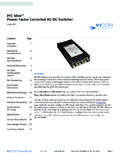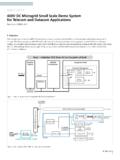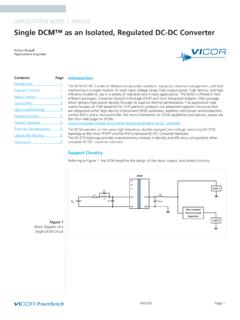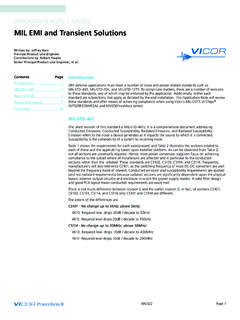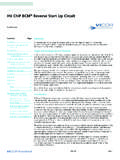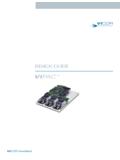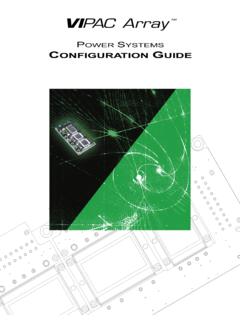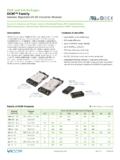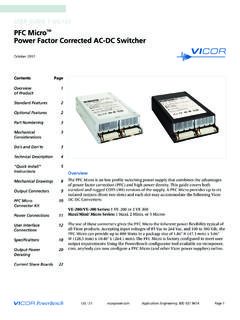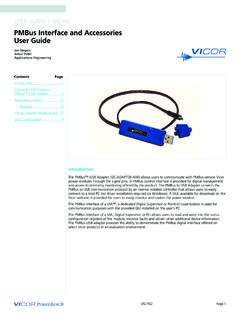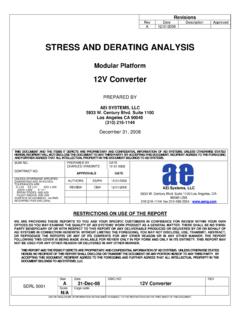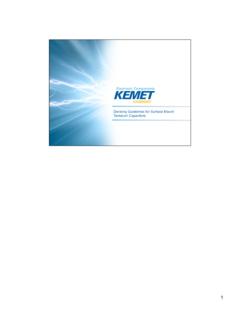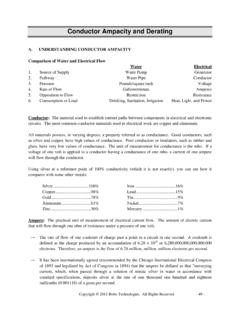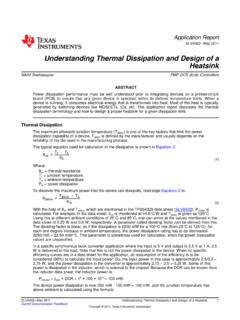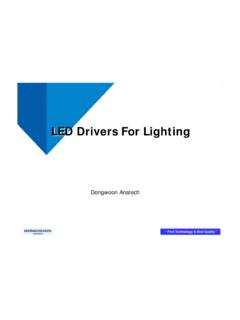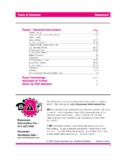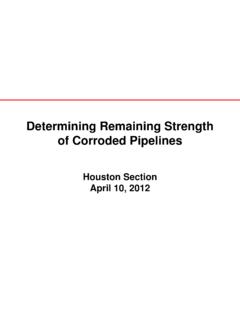Transcription of Module Construction and Component Derating - Vicor
1 Module Construction & Component DeratingModule Construction & Component Derating24 V and 300 V DC-DC Converter ModulesThis document provides a detailed view of the Construction for Maxi, Mini and Micro DC-DC converters as well as the Component designderating Vin Vin Vin Vin max. 24 Vin Vin PowerOutput PowerOutput PowerOutput PowerOutput PowerOutput Power2 VN/A160 WN/A100 WN/A50 V264 W264 W150 W150 W75 W75 W5 V400 W 400 W200 W200 W100 W100 W12 V400 W500 W200 W250 W100 W150 W15 V400 W500 W200 W250 W100 W150 W24 V400 W500 W200 W250 W100 W150 W28 V400 W500 W200 W250 W100 W150 W36 V400 W500 W200 W250 W100 W150 W48 V400 W500 W200 W250 W100 W150 WMaxi converter example:Mini converter example: Micro converter example.
2 V24A12M400 BLV300B28H250BL2V24C5M100BL324 Vin, Maxi, 12 VOUT@ 400 W, 300 Vin, Mini, 28 VOUT@ 250 W, 24 Vin, Micro, 5 VOUT@ 100 W, long solder pins, slotted baseplatelong solder pins, threaded baseplatelong solder pins, thru-hole baseplate*Compatible with the InMate and SurfMate socketing factory for other input / output / power GradeOutputPin StyleBaseplateVoltageA = MaxiVoltageE = 10 to +100 CPowerBlank = Short solderBlank = SlottedB = MiniC = 20 to +100 CL = Long solder2 = ThreadedC = MicroT = 40 to +100 C*S = Short ModuMate3 = Thru holeH = 40 to +100 C*N = Long ModuMateM = 55 to +100 CModule Size/Power ChartPart NumberingQualification Testing AccelerationTo determine the ability of parts to withstand constant acceleration, as an indicator of the mechanical strength.
3 MIL-STD-810F, Method , Procedure II Environment:Acceleration step from 2 7 g, 6 direction AltitudeTo observe low air pressure effects on either operational or non-operational design :MIL-STD-810F, Method , Procedure I & II Environment: 40,000 ft. and 70,000 ft. operational Explosive AtmosphereTo determine the ability of equipment to operate in the presence of an explosive : MIL-STD-810F, Method , Procedure I, operational Environment: Fuel-air explosive atmospheres HALT Demonstrates product design margin and robustness. Standard: Vicor internal reference EIAJESD22-A110-B Environment: Operational limits verified / destruct limits determined High Temperature Operational LifeAn operational test used to detect thermally activated failure : Vicor internal reference EIAJESD22-A110-BEnvironment: Nominal line, 75% Load, temperature within 5 C max operational HumidityA humidity test simulates the moisture-laden air found in tropical regions.
4 Standard: MIL-STD-810F, Method Environment: 240 hours, 95% RH Mechanical ShockTo determine the ability to withstand mechanical shocks from suddenly applied forces or an abrupt change in motion produced by handling, transportation or field : MIL-STD-810F, Method , Procedure I Environment: Functional shock, 40 gStandard: MIL-S-901D, lightweight hammer shock Environment: 3 impacts/axis, 1, 3, 5 ft. Standard: MIL-STD-202F, Method 213B Environment: 60 g, 9 ms half sine; 75 g, 11 ms saw tooth shock. Random Mechanical VibrationTo evaluate the Construction , materials and mounting of the device for : MIL-STD-810F, Method , Procedure I, Category 14 Environment: Sine and random vibration for helicopter AH-6J main rotor with overall level of g for 4 hours per axisStandard: MIL-STD-810F, Method , general minimum integrity Environment: g for 1 hour per axis.
5 Resistance to SolventsTo verify that Component markings will not become illegible and that electrical and mechanical integrity will not be disturbed when exposed to : MIL-STD-202G, Method 215K Environment: Ambient temperature, ambient humidity Temperature Humidity BiasAn operational test that evaluates the reliability of the device package in humid : JESD22-A101-B Environment: 85 C, 85% RH, high line input voltage Thermal ShockTo determine the resistance of the part to sudden changes in temperature. Standard: MIL-STD-202G, Method 107G, Condition B1 and MIL-HDBK-344A Environment: -65 C to 125 C, 1,000 cycles Temperature CycleConducted to determine the ability of devices to withstand mechanical stresses induced by alternating high and low temperature extremes.
6 Standard: JESD22-A104-B Environment: -40 C to 125 C, 1,000 cyclesCharacterization Process Electro Static DischargeClassifies the device according to its susceptibility to damage or degradation by exposure to electrostatic : MIL-STD-883C, Method 3015 Environment: Ambient temperature, ambient humidity FungusTo determine if a material(s) will support the growth of specific fungi. Standard: MIL-STD-810F, Method Environment: Severe climate conditions Salt FogTo determine the resistance of the equipment to the effects of a salt atmosphere, primarily : MIL-STD-810F, Method Environment: Salt fog harsh environment Solderability To evaluate the solderability of terminations that are normally joined by a soldering : MIL-STD-202G, Method 208H Environment: Continuous solder coating for a minimum of 95% surface area Terminal StrengthDetermines the resistance to external force on the : MIL-STD-202G, Method 211A, Test Condition A Environment.
7 Ambient temperature, ambient humidity AMCOM TestingDeveloped in partnership with the Army Aviation and Missile Command to demonstrate the ability to withstand sequential harsh environments, which simulate storage, field use and a 10 year service life in a ground mobile : US Army Aviation and Missile Command Environment: High temp / high humidity, temp cycle, power cycle "55,9 "12,7 "116,8 "36,8 "57,9 "57,9 mm11114255667788991010111211123342 BaseplateProvides mounting, mechanical rigidityand heat MLPMain switch and common drain for low conducted and radiated noiseInsert MoldedFunctions as an EMI shield to reduce conducted andTerminal Blockradiated noise.
8 Supplies electrical isolation for the pinsand Shieldand provides mechanical protection for the MLPA dual diode rectifierMain TransformerProvides voltage transformation and primary to secondary CapacitorReduces reflected ripple and conducted noise in conjunction with the input reflected ripple and conducted noise in Input Inductorconjunction with the input InductorReduces output ripple in conjunction with the output CapacitorReduces output ripple in conjunction with the output CapacitorQuasi-resonant tank for zero-current- switchingconverterBrain (primary)Contains primary control device (ASIC).
9 Brain (secondary)Contains secondary control device (ASIC).EncapsulantTwo Component silicone elastomerMTBFMIL-HDBK-217F: @ 25 C BaseplateMTBF in 1000 hoursPRISM ties together several tools into a comprehensive system reliability prediction methodology that accountsfor the myriad of factors that can influence VOUTMaxi5 VOUTMiniV24A24M400 BLV24B5H200 BLAluminum 6063T-5 Aluminum 6063T-5 Quantity: 6 Quantity: 3121 C (150 C)126 C (150 C)37 V (60 V)35 V (60 V) j = 10 C/W j = 10 C/WDuPont Zenite/DuPont Zenite/Clad AluminumClad AluminumQuantity: 4 (forward) + 8 (shunt)Quantity: 4 (forward) + 4 (shunt)Forward: 117 C (150 C)Forward.
10 121 C (150 C)87 V (200 V)21 V (45 V)Shunt: 105 C (150 C)Shunt:115 C (150 C)87 V (200 V)21 V (45 V) j = 10 C/W j = 10 C/W110 C (180 C) core116 C (180 C) coreQuantity: 42 Quantity: 1424 V (50 V)24 V (50 V)Quantity: 4 Quantity: 1101 C (180 C) core104 C (180 C) coreQuantity: 4 Quantity: 2102 C (180 C) core117 C (180 C) coreQuantity: 43 Quantity: 424 V (50 V)5 V (10 V)Quantity: 20 Quantity: 1087 V (250 V)21 V (50 V)102 C (135 C)108 C (135 C)102 C (135 C)108 C (135 C)Thermal conductivity: W/m-kTemperature rating guide: 200 V Inpu123456789101112 The photos to the left illustrate typical Maxi, Mini and Micro DC-DC converters and the captions below provide information as to materials and operating parameters.
